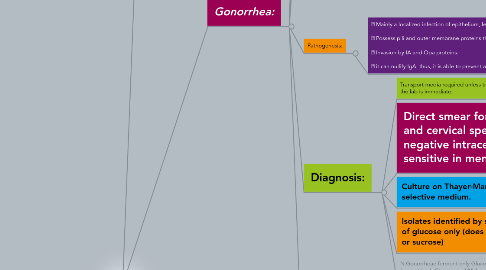
1. Syphilis:
2. Gonorrhea:
2.1. Neisseria Gonorrhea is a gram negative diplocooci which causes the STD gonorrhea.
2.2. It can be cultured
2.3. STD acquired by direct genital contact.
2.4. Clinical manifestations:
2.4.1. incubtion period [IP] 2-5 days
2.4.2. Men:
2.4.2.1. acute urethritis and acute profuse purulent urethral discharge.
2.4.3. Women:
2.4.3.1. mucopurulent cervicitis
2.4.3.2. urethritis with discharge
2.4.3.3. Pelvic inflammatory disease (PID) in women
2.4.3.3.1. Salpingitis and pelvic peritonitis cause scarring and infertility.
2.4.3.3.2. PID occurs in 10-20% of cases, including fever, lower abdominal pain, adnexal tenderness, leukocytosis with or without signs of local infection.
2.4.4. In both sexes:
2.4.4.1. urethritis
2.4.4.2. proctitis
2.4.5. Symptoms similar to Chlamydia infection
2.4.5.1. BUT
2.4.5.1.1. Chlamydia thin discharge.
2.4.5.1.2. Gonorrhea purulent discharge
2.4.6. Pharyngitis may occur.
2.4.6.1. Due to oral sex
2.4.7. Disseminated Gonococcal Infection:
2.4.7.1. Due to spread of the bacteria to the bloodstream.
2.4.7.2. Clinically: Fever, migratory arthralgia and arthritis. Purulent arthritis involving large joints. Petechial, maculopapular rash.
2.4.7.3. Metastatic infection such as Endocarditis, Meningitis & Perihepatitis may develop.
2.5. Pathogenesis:
2.5.1. Mainly a localized infection of epithelium, leads to intense inflammation. Possess pili and outer membrane proteins that mediate attachment to non-ciliated epithelium. Invasion by IA and Opa proteins. it can nullify IgA, thus, it is able to prevent an immune response.
2.5.1.1. it has IgA proteases so it breaks the IgA
2.6. Diagnosis:
2.6.1. Transport media required unless transfer to the lab is immediate.
2.6.2. Direct smear for Gram stain of urethra and cervical specimens to see Gram negative intracellular diplococci, more sensitive in men.
2.6.3. Culture on Thayer-Martin or other selective medium.
2.6.3.1. selective bcoz the vagina & urethra has a lot of bacteria !! so selective media to kill other bacteria.
2.6.4. Isolates identified by sugar fermentation of glucose only (does not ferment maltose or sucrose)
2.6.4.1. or Coagglutination test.
2.6.5. N.Gonorrheae ferment only Glucose. N.Meningitidis ferment both Glucose and Maltose.
2.7. Treatment:
2.7.1. Guided by local resistance pattern and susceptibility testing. Partner should be treated as well.
2.7.2. Ciprofloxacin or Ofloxacin.
2.7.2.1. Fluoroquinolone
2.7.3. Counselling
2.7.4. Ceftriaxone IM (or oral Cefixime recommended).
2.7.4.1. 3rd generation cephalosporin
2.7.4.2. Ceftriaxone it cannot be broken down by penecilinase in Penecllinase Producing Nessehrrhea Gonorrhea (PPNG).
2.7.4.3. New Node
2.7.5. Azithromycin, Doxycycline (orally for 7 days)
2.7.5.1. both cover C.trachomatis infection as well.
2.7.5.2. if we suspect chlamydia we give Azithromycin bcoz it will kill both of them.
3. Chlamydia:
3.1. obligatory intracellular organisms
3.2. Classification in Table in 431 Team work
3.3. They don't have a rigid cell wall.
3.3.1. Therefore, Beta lactam antibiotics cannot be used to treat Chlamydia infections.
3.4. Chlamydia Trachomatis is a common cause of sexually transmitted disease (STD)
3.4.1. Spread by genital secretions, anal or oral sex.
3.5. Human are the sole reservoir. (It is completely a human disease, unlike C.psittaci)
3.6. Pathogenesis:
3.6.1. Chlamydia have tropism for epithelial cells of endocervix and upper genital tract of women, urethra, rectum and conjunctiva of both sexes.
3.6.1.1. (This is why if we want to investigate we take endocervical swab)
3.7. Genital infections caused by C. trachomatis:
3.7.1. in Men:
3.7.1.1. urethritis (non gonococcal Urethritis, NGU)
3.7.1.1.1. Urethritis present as dysuria and thin urethral discharge in 50% of men.
3.7.1.1.2. New Node
3.7.1.2. epididymitis
3.7.1.3. proctitis
3.7.2. in Women:
3.7.2.1. cervicitis
3.7.2.1.1. Uterine cervix infection may produce vaginal discharge but is asymptomatic in 50-70% of women
3.7.2.1.2. New Node
3.7.2.2. salpingitis
3.7.2.2.1. Salpingitis and pelvic inflammatory disease can cause sterility and ectopic pregnancy.
3.7.2.3. urethral syndrome
3.7.2.4. endometritis
3.7.2.5. proctitis
3.8. Diagnosis:
3.8.1. Polymerase chain reaction (PCR) is the most sensitive method of diagnosis. Performed on vaginal, cervical, urethral swabs, or urine.
3.8.2. Isolation on tissue culture (McCoy cell line) but rarely done “culture on living tissue”.
3.8.3. C.tracomatis inclusions can be seen by iodine or Giemsa stained smear
3.9. Treatment:
3.9.1. Remember we CANNOT USE BETA LACTAMS!
3.9.2. Macrolides
3.9.2.1. Azithromycin
3.9.2.2. Erythromycin
3.9.3. Tetracycline
3.9.3.1. Doxycycline
3.9.3.1.1. Doxycycline should not be used in small children and pregnant women because of the effects of tetracycline on calcification bones & Teeth.

